Amended: post shoot review at the bottom
The solar eclipse on Monday Aug 21st 2017 is fast approaching. If you haven’t already gotten your gear in order you might be too late with items such as solar ND filters and viewing glasses (except the ones Amazon are refunding!) having pretty much sold out. Hotels have been booked up for months, but the best plan is to stay mobile to position yourself according to cloud cover.
There are many good blogs out there about what gear is needed, but as a storm chaser I want to share some strategy tips as well as some of the lesser known facts.
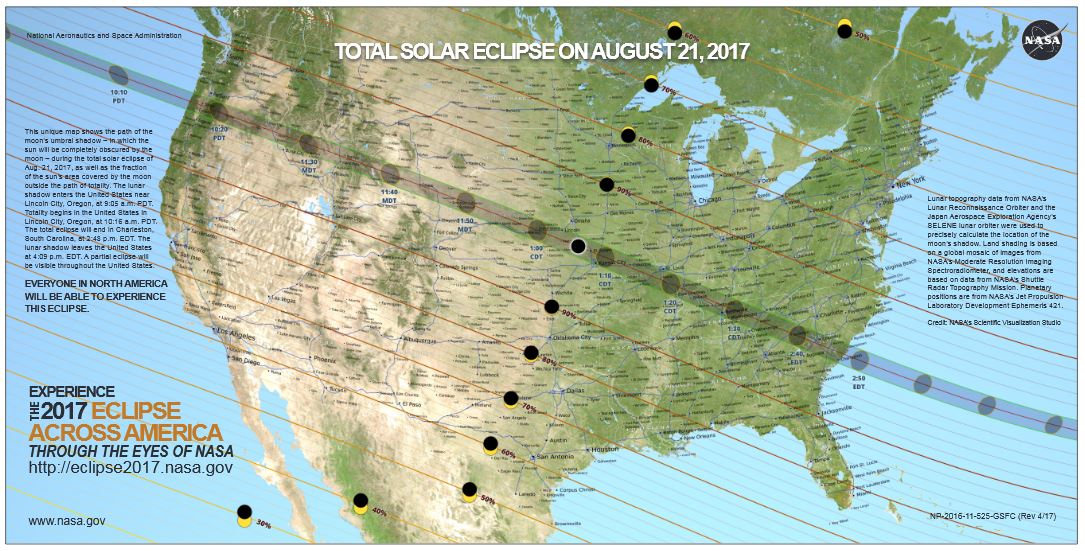
Above NASA’s map of the eclipse path and the percentage of eclipse coverage in different areas with times. Click here to see more detail on the NASA Website.
Also on the NASA website are more detailed maps by state:
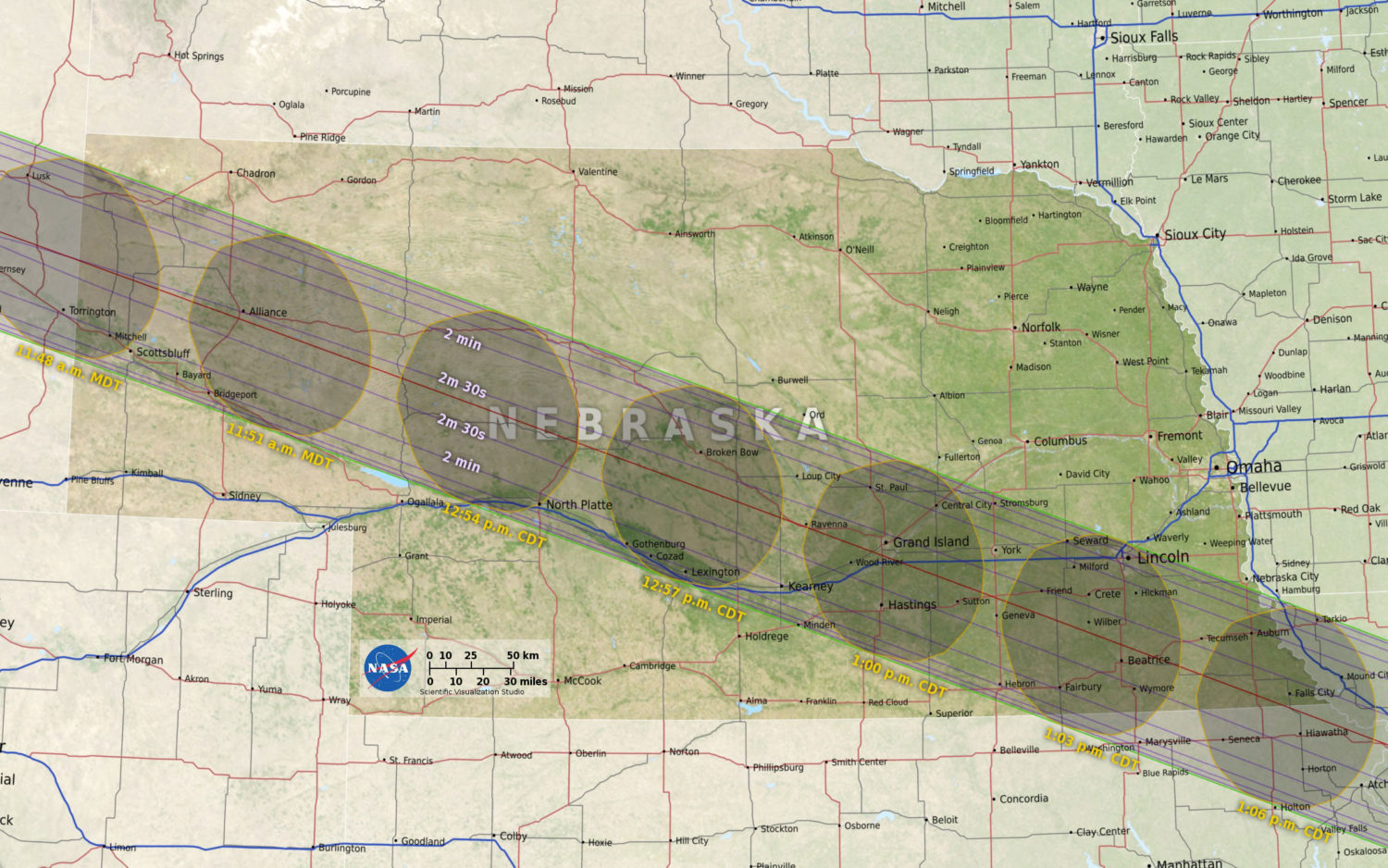
Things to NOTE:
- Across central US the eclipse will be close to midday and high in the sky, at about 57 degrees in elevation, this makes it less than ideal for a landscape style photo (see shooting tips below)
- The closer you are to the center of the eclipse umbra (shadow within which you will see the total eclipse) the longer the “totality” of the eclipse is. Maximum time is 2m 40.2s in IL
- The whole process of the moon moving across the sun takes a couple of hours.
STRATEGY
Imagine a storm chase day that guarantees a line of photogenic storms across the country at a specific time that has been known about for years. That is how I view the eclipse. We know that storm chaser convergence can make a chase difficult, such as a high risk day near Oklahoma City on a weekend. The same is going to apply to the eclipse, just amplified by a huge amount, and so it requires some planning.
- STAY MOBILE. Forecast for cloud cover and adjust accordingly
- PLAN FOR CROWDS. Arrive early. Preferably scout ahead of time. Apparently some police are not allowing traffic to stop by the roadside.
- BRING SUPPLIES. Food, drink and possibly extra gas – there will be long lines to fuel up and some gas stations are expected to run out.
- PACK YOUR GEAR. Solar glasses, camera gear, sunscreen! Also bring a laptop to edit in case you get blocked by traffic trying to escape.
To plan your timing here is a great interactive map I found on timeanddate.com where you can choose your location and it determines the timings of the event:
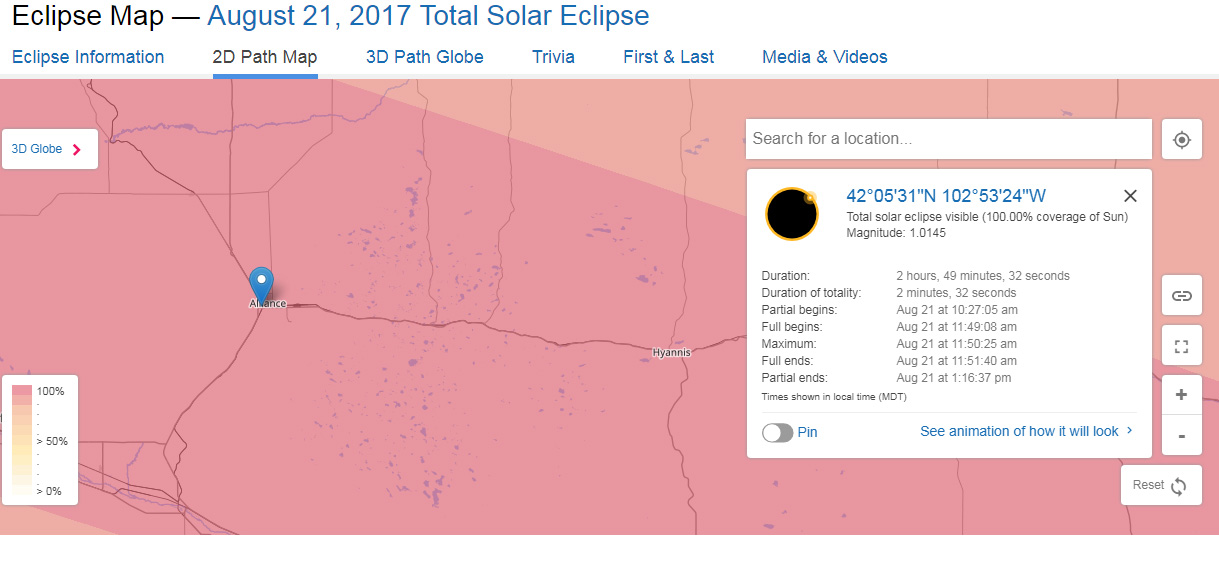
FACTS
- The population of Wyoming is expected to double for the solar eclipse
- Animals may believe it is night time: Frogs and birds may become noisy, cows may head to the barn.
- Pets as well as humans can suffer eye problems from starring at the sun during the eclipse. As pets tend to not look directly at the sun this should not be an issue, but who knows!
- Air temps can drop as the sun is obscured
FORECASTING
The forecast models keep changing, but the GFS long term outlook cloud cover for the USA at noon Mountain Time looked like this:
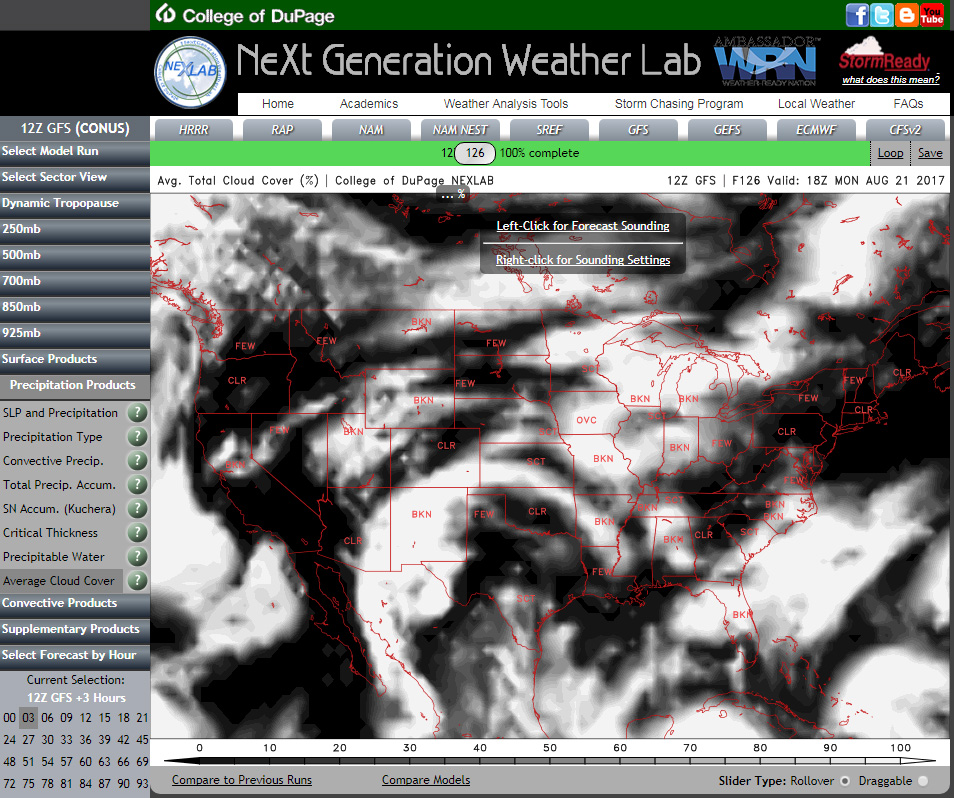
This is why I suggest staying mobile. The models having been changing some, but at this point I am considering Alliance Nebraska, plus there is better road network there to allow for heavy traffic. I think the I-25 corridor in Wyoming will be horrible – yup, traffic jams in Wyoming might just be possible! Don’t forget when you look at the models that you will be looking upwards and to the south.
To forecast go to the College of DuPage Nexlab Numerical Model Page. Look at the gray tabs along the top and click on GFS for long term, NAM within 4 days. You could click the map to chose an area or leave it on the full US map. On the left menu open “Precipitation Products” then “Average Cloud Cover”. Along the top is a slider to run through the hours, given in Greenwich Meantime (London) so being summer -4 hours for Eastern Time, -5 Central, -6 Mountain, -7 Pacific. If the model is still updating you can open “Select Model Run” at the top of the left side menu to go back to the last forecast run. On the day of use the HRRR model, live satellite images or look up!
SHOOTING
There are 2 potential ways to photograph the eclipse, zoomed into the sun or wide angle. Use a solar ND filter when shooting the sun until totality occurs, otherwise the sensor could get burnt by the sun. I just received my ND18 filter and compared it to my ND16, there is a different finish to it that may be protection from rays but might might just be a cast correction.

Image from B&H photo’s blog
Telephoto
Zoom in to get the detail of the sun. One of the things I am hoping for is what is known as the diamond ring, one of the last stages of light before totality with one spark of light. Use an ND filter until totality. During the couple of minutes of totality you can remove the filter. Bracket away!! This way you can capture different segments of the corona extending out from the sun.
Wide Angle Landscape
As the sun will be high in the sky the wider the better in order to capture a foreground and the sun, which at Alliance NE for example should be at 57 degrees in the sky. I sold my 16-35mm earlier this year for the 11-24mm which unfortunately does not allow for screw on filters and other filters are a small fortune. I therefore must use my 24-70mm which may not be wide enough. The plan is orient the camera vertically during a test shoot to see if I can fit it in, otherwise I will stitch images getting the foreground in first. Since I will be using the ND 16 non solar filter I hope to cover the lens between shots, using an interval timer release.
Also as you are shooting into the sun remember that your foreground will be silhouetted. You might be able to extra exposures to get the foreground detail but the final image might not look natural and the sun might end up burning in to the sensor – not sure on that, but food for thought. Once totality is occurring lighting would be more even. Maybe consider a flash light for painting with light? Of course the chances of viewing alone are very unlikely and painting by light or using a flash will impact photos and the adjustment to low light of others around you. Not familiar with your camera settings? Tape over the flash to prevent auto firing.
Sony a7rII – one big benefit of the Sony is that the on screen display adjust the exposure to the settings you are using, even with an ND filter on it. With Canon I would have to focus and set up without the ND filter on.
Exposure
Here is a guide to exposure settings. However this does not account for the use of filters, so I am not really sure just how helpful it is. I will establish some settings from my tests with the filters in the next few days. Best advice is BRACKET! You only have one shot to get it right so best get it right.
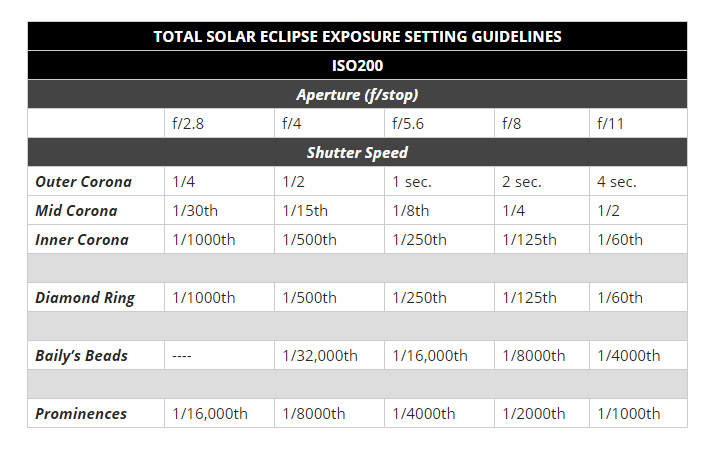
Quick Tips:
- Take practice shots to establish rough exposures before the big day
- Bracket!!
- Check the screen for exposure with the histogram and sharpness
- Tripod and cable release so as to not move the camera
- Extra batteries and memory cards
DO NOT LOOK DIRECTLY AT THE SUN WITH THE NAKED EYE. It can cause permanent damage or even blindness
Do not pull faces, if the wind changes direction you will be stuck looking like that for life
One of the above is a wives tale, told by Mothers to their kids. The other is not. You decide!
Other good blogs:
POST EVENT REVIEW
Totality goes much quicker than expected! I did not have time to do everything I wanted, here are some tricks to keep in mind for 2024:
A solid tripod is a great help, I used mine sheltered behind a bank of dirt that I was lucky to find as it was windy and lowered my tripod legs to a minimum
- Screw on filters will screw up the focus, buy a drop on filter
- Keep both/all cameras close – I did not even get to fire off my wide angle during totality
- For the wide angle shots I did not use a filter and bracketed using aperture priority, slowly removing the lens cap so it adjusted to the new light
- The drop on caps helped so as to prevent the sensor burning.
- I did not use the ND 18 solar filter, it was too dark. I stacked 2 ND filters to give 9 stops and dropped on the self made cap between shots. This shortened the shutter speed and helped keep the image sharp along with the use of a remote trigger.
- I saw no ill affects to my cameras from not using a solar filter. Is it just a marketing ploy? Or is it assuming the camera will constantly be exposed to the sun?
- As the sun gets closer to totality increase the exposure. I did not get a good shot of the diamond ring.
- Focus on totality and the diamond ring as these are the best shots. The moon moving across is only OK in my opinion.
Here are a couple of images I did get and am happy with:

“Totality” One exposure but using the circle filter in Lightroom I increased the exposure the further out I went.

“Space”. Nice and simple to give the feeling of space.
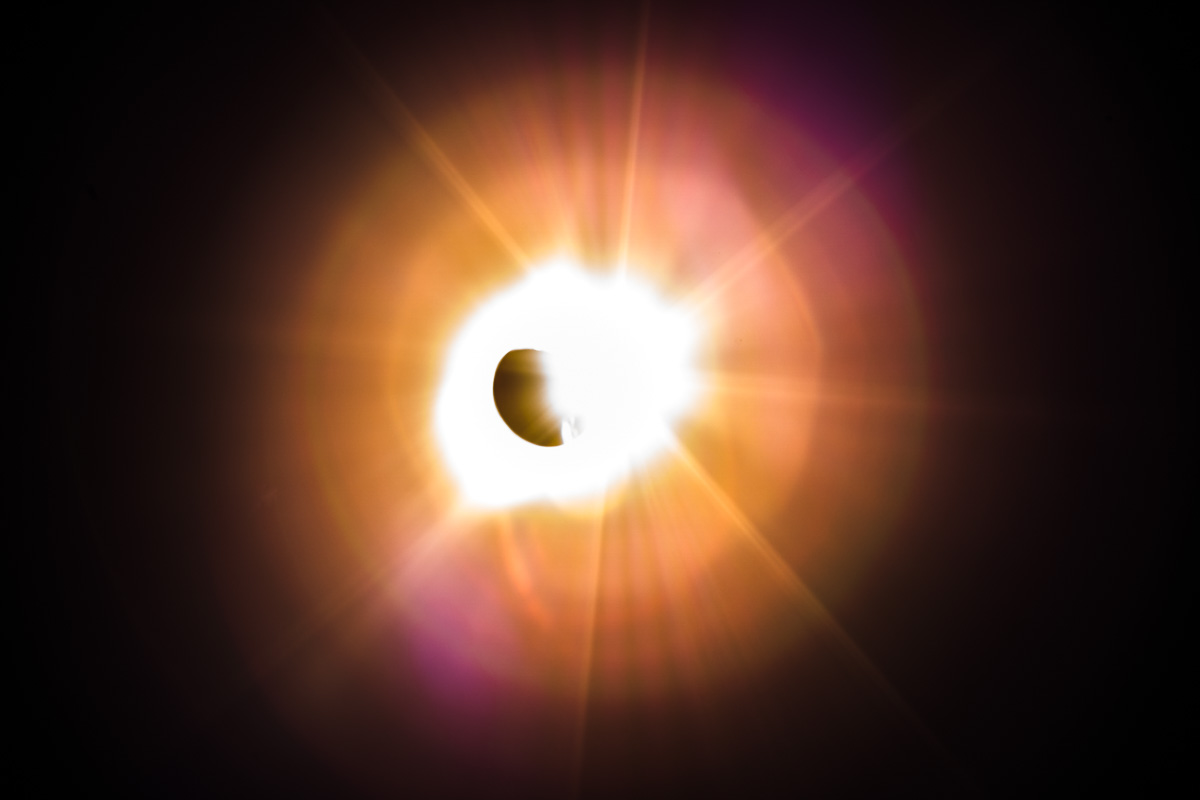
This was the diamond ring moment before I got my filters on! So it was totally over exposed.
Sony a7rII
A few big benefits of using the Sony a7rII camera:
- Live view adjust adapts to the proposed exposure allowing me to see the sun with 9 stops of filters on and I could focus
- Adjustable screen angle allowed me to lower my tripod while pointing up and still see the screen without crawling on the ground
- High dynamic range allowed me to draw out the corona from one image
- Mirrorless meant no camera shake from the shutter and no temptation to look through a view finder and fry my eyes!
4 comments
I’m from Alliance, live in Omaha now. It will be a great place. Try out be the Alliance Cemetary or on the east
Side of town in the country! I’ll be anxious to see you pictures!
Linda N
Please do not use a camera flash or a flashlight for “painting with light.” Many photo sites recommend putting electrical tape over your camera’s flash if you are not positive that you can turn it off.
A flash or flashlight can impact the vision of nearby viewers and potentially spoil the experience of other viewers and photographers. It is important to not introduce external light sources to an eclipse viewing. A nice idea for night shots, but not for an eclipse. Thanks for considering this! Thanks also for your other eclipse tips!
Thanks for these great tips. Amy from Chicago.
Hey Amy! See you next weekend 🙂